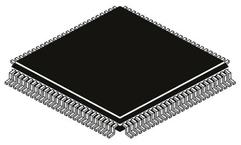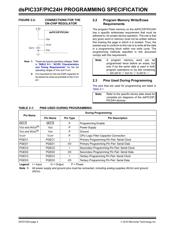herunterladen

© 2010 Microchip Technology Inc. DS70152H-page 1
dsPIC33F/PIC24H
1.0 DEVICE OVERVIEW
This document defines the programming specification
for the dsPIC33F 16-bit Digital Signal Controller (DSC)
and PIC24H 16-bit Microcontroller (MCU) families. This
programming specification is required only for those
developing programming support for the dsPIC33F/
PIC24H family. Customers using only one of these
devices should use development tools that already
provide support for device programming.
Topics covered include:
1.0 Device Overview ......................................................... 1
2.0 Programming Overview of the dsPIC33F/PIC24H ...... 1
3.0 Device Programming – Enhanced ICSP ..................... 8
4.0 The Programming Executive ..................................... 19
5.0 Device Programming – ICSP .................................... 28
6.0 Programming the Programming Executive
to Memory ................................................................. 45
7.0 Device ID................................................................... 50
8.0 AC/DC Characteristics and Timing Requirements .... 54
Appendix A: Hex File Format .............................................. 57
Appendix B: Device ID Register Silicon Errata Addendum . 58
Appendix C: Diagnostic and Calibration Registers ............. 59
Appendix D: Checksum Computation ................................. 61
Appendix E: Revision History.............................................. 74
2.0 PROGRAMMING OVERVIEW
OF THE dsPIC33F/PIC24H
There are two methods of programming the dsPIC33F/
PIC24H family of devices discussed in this
programming specification. They are:
• In-Circuit Serial Programming™ (ICSP™)
programming capability
• Enhanced In-Circuit Serial Programming
The ICSP programming method is the most direct
method to program the device; however, it is also the
slower of the two methods. It provides native, low-level
programming capability to erase, program and verify
the chip.
The Enhanced ICSP protocol uses a faster method that
takes advantage of the programming executive, as
illustrated in Figure 2-1. The programming executive
provides all the necessary functionality to erase,
program and verify the chip through a small command
set. The command set allows the programmer to
program the dsPIC33F/PIC24H Programming
Specification devices without having to deal with the
low-level programming protocols of the chip.
FIGURE 2-1: PROGRAMMING SYSTEM
OVERVIEW FOR
ENHANCED ICSP™
This specification is divided into major sections that
describe the programming methods independently.
Section 3.0 “Device Programming – Enhanced
ICSP” describes the Enhanced ICSP method.
Section 5.0 “Device Programming – ICSP”
describes the ICSP method.
2.1 Power Requirements
All devices in the dsPIC33F/PIC24H family are dual
voltage supply designs: one supply for the core and
another for the peripherals and I/O pins. A regulator is
provided on-chip to alleviate the need for two external
voltage supplies.
All of the dsPIC33F/PIC24H devices power their core
digital logic at a nominal 2.5V. To simplify system
design, all devices in the dsPIC33F/PIC24H
Programming Specification family incorporate an
on-chip regulator that allows the device to run its core
logic from V
DD.
The regulator provides power to the core from the other
V
DD pins. A low-ESR capacitor (such as tantalum) must
be connected to the V
CAP pin (Figure 2-2). This helps
to maintain the stability of the regulator. The
specifications for core voltage and capacitance are
listed in Section 8.0 “AC/DC Characteristics and
Timing Requirements”.
dsPIC33F/PIC24H
Programmer
Programming
Executive
On-Chip Memory
dsPIC33F/PIC24H Flash Programming Specification
Verzeichnis








